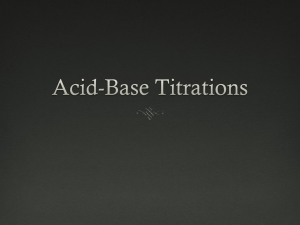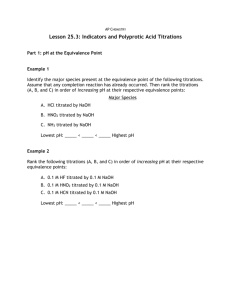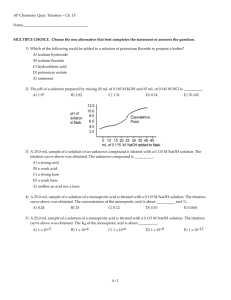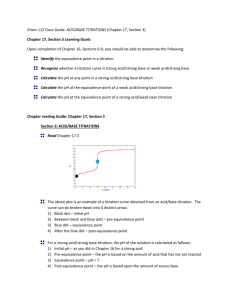H 3 O +
advertisement
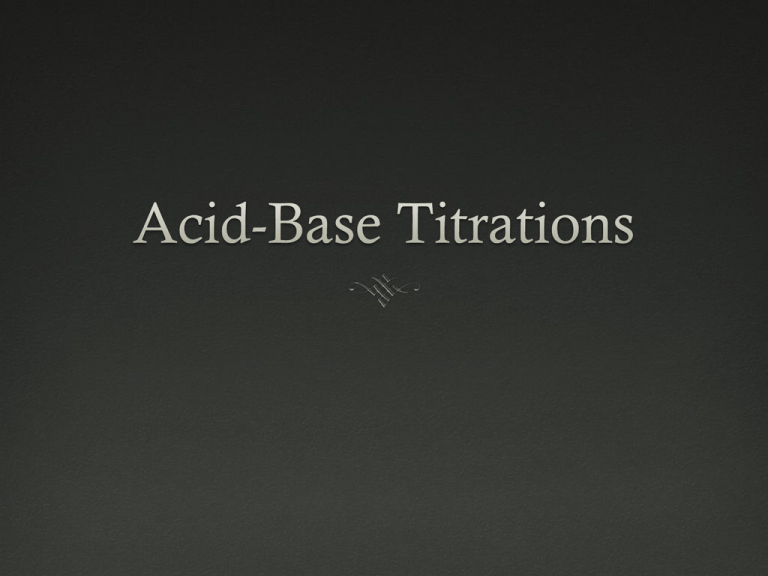
Titration Lab technique commonly utilized to determine an UNKNOWN concentration of a chemical compound with a KNOWN concentration of another chemical compound. Chemical compounds combine with exact stoichiometric proportions Analyte— Chemical compound with unknown concentration Titrant— Chemical compound with known concentration Measured with volume and concentration Added to chemical compound with unknown concentration in titration Acid-Base Titration Technique used to perform a neutralization reaction Acid/Base with KNOWN concentration used to determine acid/base with UNKNOWN concentration Neutralization Reaction: Acid + Base Salt + H2O Titration Terminology End Point: point in a titration where a color change is observed due to indicator. Equivalence Point: point during a titration when neutralization has occurred. Equal amount of acid and base Cannot usually be observed We can plot a titration on a graph—titration curve **Ideally, equivalence point = endpoint ** 2 Types of Acid-Base Titrations 1) Strong Acid/Strong Base Titrations 2) Weak Acid/Strong Base Titrations 1. Strong Acid/Strong Base Titrations Low initial pH value Sharp increase in pH before equivalence point Equivalence point is pH = 7 Rapid pH increase after equivalence point **Indicators with pH range 4-10 helpful for these titrations **Neutralization reactions Strong Acid with Strong Base Titrant Strong Base with Strong Acid Titrant Example 1: Strong Acid/Strong Base Titration Calculations 30 ml of 0.50M HCl is titrated with 0.50M NaOH. a) Find the pH of 0.50M HCl Example 1: Strong Acid/Strong Base Titration Calculations 30 ml of 0.50M HCl is titrated with 0.50M NaOH. b) Find the pH after 15 ml of NaOH added Example 1: Strong Acid/Strong Base Titration Calculations 30 ml of 0.50M HCl is titrated with 0.50M NaOH. c) Find the pH after 30 ml of NaOH added Example 1: Strong Acid/Strong Base Titration Calculations 30 ml of 0.50M HCl is titrated with 0.50M NaOH. d) Find the pH after 45 ml of titrant added 2. Weak Acid/Strong Base Titrations High initial pH value pH = pKa at half-neutralization [weak acid] = [conjugate base] Ka = [H3O+] [A -] [HA] SO Ka = [A-]/[HA] is 1:1 Ka = [H3O+], SO pH = pKa 2. Weak Acid/Strong Base Titrations Equivalence point > 7 on pH scale **Indicators with pH range > 7 helpful as pH equivalence point is basic Example 1: Weak Acid/Strong Base Titration Calculations 30 ml of 0.5M HC2H3O2 titrated with 0.50M NaOH. Ka for acetic acid is 1.8x10 -5. a) Find the initial pH of 0.5M acetic acid. HC2H3O2 + OH- C2H3O2- + H2O (titration view) HC2H3O2 H+ + C2H3O2- (in detail) Example 1: Weak Acid/Strong Base Titration Calculations b) Find the pH after 15ml of NaOH were added pH = pKa + log [C2H3O2-] / [HC2H3O2] -used when dealing with buffer solutions -buffer—mixture of weak acid/conjugate base -more on this concept later Example 1: Weak Acid/Strong Base Titration Calculations c) Find the pH at the equivalence point. C2H3O2- + H2O HC2H3O2 + OH- Example 1: Weak Acid/Strong Base Titration Calculations c) Find the pH after 40ml of NaOH are added to 30ml of 0.50M HC2H3O2. Homework Titration Worksheet


